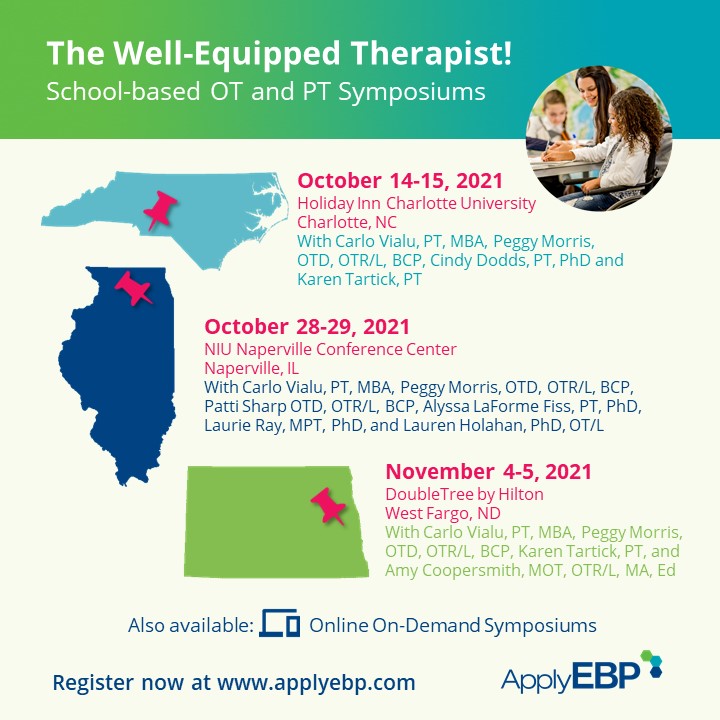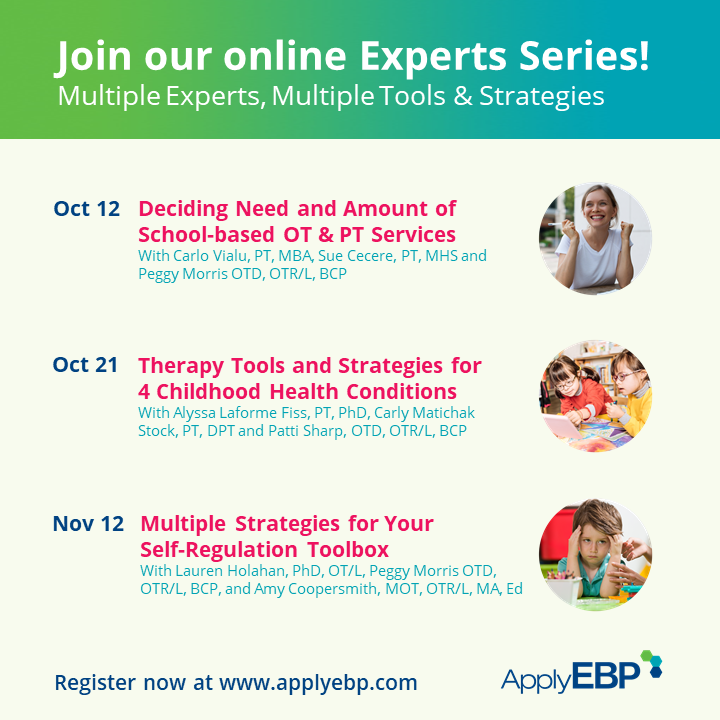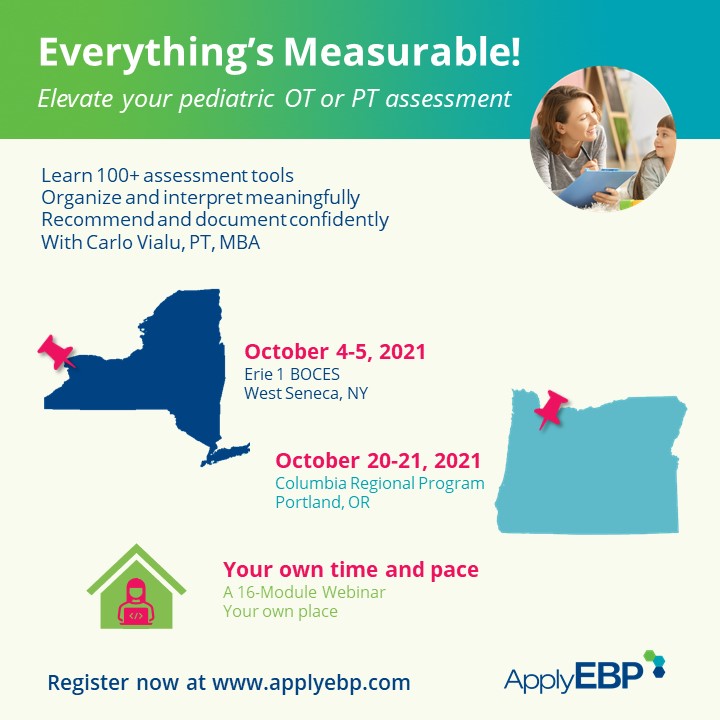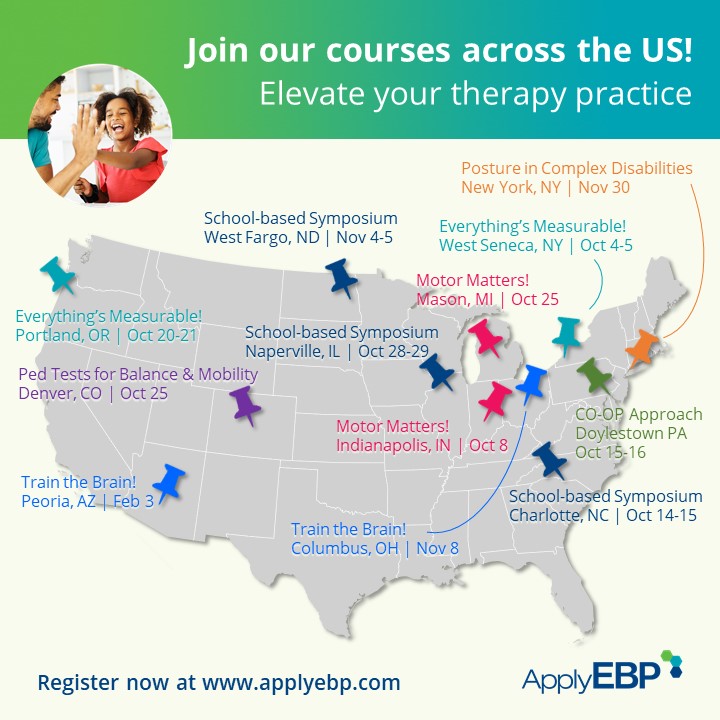Click here for an updated version of this article with current links, evidence and resources.
Carlo Vialu, PT, MBA, is co-creator of SeekFreaks. He loves promoting function and participation for children and youth with disabilities, from our assessment to our interventions, via his continuing education courses: The Well-Equipped Therapist! School-based OT & PT Symposiums, Everything’s Measurable, and the live online Experts Series. Read more about these courses after the article.
3 summers ago, we published SeekFreaks’ Summer Reading for school-based therapists! It quickly became our most-read article – so we know such resource is much-needed.
In the intervening 36 months, much has changed. Links have moved, web resources have been updated and – even better – new research shed light as to the effectiveness of our interventions.
So, we decided it’s time to update the summer reading list with additional resources and some advance reads of new and new-ish published articles that we SeekFreaks consider essential knowledge for school-based practitioners.
Whether this is your first job after graduation, you are an experienced therapist who is just now entering school-based practice, or you’re a seasoned school-based therapist who needs to brush up and get excited with our practice again, venture into our 2019 summer reading list…for the beach, a mountain retreat, your hammock in the backyard, those long plane rides, or wherever your summer vacation plans take you.
1. Read up on the Individuals with Disabilities Education Act (IDEA)
Read up on the Individuals with Disabilities Education Act (IDEA) – the foremost reason why there are therapists working in the schools. Learn about special education and your role as a related service provider. You can find the whole regulation here – but you will quickly realize how boring it is to read this document (sorry, IDEA – we still love you!). So, instead start with the SeekFreaks article: OTs, PTs & SLPs in Schools…How Did We Get Here?
Then, if you are…
- A PT: get a copy of Physical Therapy Services under Parts B and C of IDEA, edited by Irene R. McEwen, PT, PhD, FAPTA.
- An OT: get your hands on Best Practices in Occupational Therapy in School, edited by Gloria Frolek Clark, PhD, OTR/L, BCP, SCSS, FAOTA; Joyce E. Rioux, EdD, OTR/L, SCSS; and Barbara E. Chandler, PhD, OTR/L, FAOTA.
- An SLP: ASHA has a great School Services FAQ.
Read them as voraciously as you would read a newly released Harry Potter or Hunger Games prequel. If after reading these, you still have questions, or would like to find certain excerpts from IDEA regulations, you can use the search tab on the IDEA’s website.
Need a deeper dive into other laws affecting school-based practice? Here’s a list from SeekFreak Laurie Ray:
“There are 3 laws that are closely related to our practice. Below are the links to increase your understanding. Websites have too much info? I indicated the pages where you can start and get applicable information right away.
- Family Educational Record Privacy Act (FERPA)
- Start here: FAQs: K-12
- Americans with Disability Act (ADA)
- Start here: Technical Assistance Publications
- Section 504 of the Rehabilitation Act”
2. Read your state or school district’s school-based practice guideline
Does your state or school district have a school-based practice guideline? SeekFreaks made it easier for you to find your state guideline with our OT, PT & SLP Practice Guide Map. Print out a copy to take with you, or better yet, download a copy onto your mobile device (and save some trees in the process as some of them can be fairly long). By the way, if your state has a practice guide that is not listed in the link, let us know by commenting below or by emailing us at seekfreaks.gmail.com so we can add it.
The practice guide will give you specific guidance as to how to practice in schools within your own state or school district. It will often explain how Individualized Education Program (IEP) teams meet and make decisions, and your roles and responsibilities as a related service provider (yes, you will be considered a related service provider in school-based practice, so get used to this term).
These practice guides also often discuss decision-making processes for determining a student’s eligibility for special education services, establishing students’ goals, and identifying their needs for related services. You will also learn the areas of expertise and competencies expected of school-based therapists within your school districts. Some practice guidelines even contains discussions around service delivery models, as well as, frequency and intensity of services.
If your state and school district does not have a practice guide, do not fret. Here are some starting points to learn more about your role in the school.
- Occupational Therapy Services in Early Childhood and School-Based Settings: Published by the American Journal of Occupational Therapy, it provides guidance for OTs practicing in school-based practice.
- Role of School-based Physical Therapy: Provides a short description of the role of PTs in our schools.
- Updated Competencies for Physical Therapists Working in Schools: A list of skills and knowledge therapists need to possess to provide services to students with disabilities.
- Physical Therapy for Educational Benefit: Would you like a comparison between school-based and clinic-based practice? Here it is, created by the American Physical Therapy Association’s School-based Special Interest Group in collaboration with the Hospital-based Special Interest Group. It starts by pointing out the similarities between the two settings, followed by the differences. Although it focuses on physical therapy, you can quickly see how it can apply to OTs and SLPs.
- ASHA Roles and Responsibilities of Speech-Language Pathologists in Schools: Created by the American Speech Language and Hearing Association, this website containing various resources to learn about SLP’s role in schools, with great examples of “Dos and Don’ts.”
While you’re reading your practice guide, might as well revisit your state practice acts to review what you should do, and what you can and cannot do under your license, registration and/or certification.
- PTs can find links to all states’ practice acts here.
- SLPs can find state information here.
- OTs – unfortunately, I still can’t find a complete listing for you. If you just search online for “occupational therapy practice act” plus “the name of your state”, you should be able to find it easily.
3. Learn about the Individualized Education Program (IEP)
As school-based practitioners, Individualized Education Programs (IEPs) will be a huge part of your life. Whereas, medical-based settings use doctor’s prescriptions and medical documentation, the therapists in the educational setting rely on what is contained in the students’ IEPs.
Of course, you will find some guidelines on IEPs, including learning modules, on the IDEA website by clicking here then selecting Individualized Education Program. You can also visit your state education department’s website to find specific guidance within your state.
However, such guidance is often very general. How do they apply specifically to therapists? For this information, read the 4-part SeekFreaks series IEP 4.0 that begins here. This is a quick primer on our responsibilities in the IEP process focusing on 3 particular IEP sections, the Present Level of Academic Achievement and Functional Performance, Goals & Progress Monitoring, plus a non-IEP, but just as important item, the Plan of Care. Although, the examples are PT-related, OTs and SLPs can find pearls of wisdom that they can readily apply to their practice.
You can also help your students and their families through the IEP process with these handy-dandy checklists by SeekFreak Laurie Ray:
4. Get Cozy with the ICF
If you read materials 1-3 above thoroughly, you will realize that there is a lot of talk about participation. So you would need to brush up on the International Classification of Function, Disability and Health (ICF) so you can become fluent in describing impairments, activities and participation, and when setting participation goals with the IEP team.
It would help you to skim through the ICF-Children and Youth Version. It may be a little less tedious than reading the full IDEA regulations. However, it can still be snooze-inducing. If you like a quick primer, read Recognizing ICF Domain Words…Amusing Musings which we just updated by aligning the ICF domains with the term used in the Occupational Therapy Practice Framework (OTPF-3). Wouldn’t it be great if we all could speak each other’s lingo?!
And don’t miss CanChild’s take on the ICF with the catchy title, “F-Words”. Each F-Word corresponds to a domain of the ICF. They also just created videos and other materials to help you explain each F-Word with your colleagues and clients. Visit their F-Words Knowledge Hub.
5. Are You Up for Additional Readings?
Well, if you are reading this far, then you must be! Here are some recent and recent-ish articles that would make for great reading summer reading to make you extra-effective in school-based practice. This list includes free articles, systematic reviews and websties on general school-based topics and interventions, and those that pertain to some of the most common pediatric health conditions.
- ASHA/N-CEP Evidence-based Systematic Reviews: Where you will find a collection of SLP-related systematic reviews on various topics and interventions.
- Effectiveness of Paediatric Occupational Therapy for Children with Disabilities: A Systematic Review by Iona Novak and Ingrid Honan (2019) – Oh, what a mind blower! A big thanks to both authors for synthesizing into a graphic traffic-light format what works and what doesn’t. There’s so much Yahoos, Uh-Ohs and Hmmms that will keep you reading and debating this with your colleagues. Don’t let the title fool you. Many of the articles reviewed did include not just OT but also PT, and a couple included Speech interventions. Also, read Peggy Morris’ SeekFreaks take on this article before you dive in to the whole article.
- Determining Need for School-based Physical Therapy under IDEA: Commonalities Across Practice Guidelines by Vialu and Doyle (2017) – Yes, shameless self-promotion. My colleague, Maura and I delved through practice guidelines that were accessible online to come up with commonalities how to decide the need for school-based PT services. We then proceeded to turn the 7 commonalities we found into 2 Procedural Requirements, and 5 yes/no questions that your IEP team can adopt. Yes, this article covers only PT services. We do have plans to write a similar article for OT (and perhaps, Speech) services when we do find the time. However, I won’t be surprised if the results will be similar since most guidelines cover both OT and PT, and some even all 3 services.
- How about some quick SeekFreaks list of handy fact sheets and resources:
Can’t have enough to read? Here are some SeekFreaks’ picks on more EBP:
- International clinical practice recommendations on the definition, diagnosis, assessment, intervention, and psychosocial aspects of developmental coordination disorder (2019) – This recently updated synthesis is a must-read if you are working with children and youth with DCD. Learn the best approaches for assessment and interventions.
- AFIRM’s Evidence-based Practices
(EBPs) for Individual with Autismv – Go through their site, click on a
specific EBP and learn more about effective strategies you can include in your
toolbox. For additional readings on Interventions for Individuals with ASD
- Similar to AFIRM’s but can be printed out into a book – Wong, C., Odom, S. L., Hume, K. A., Cox, A. W., Fettig, A., Kucharczyk, S., … & Schultz, T. R. (2015). Evidence-based practices for children, youth, and young adults with autism spectrum disorder: A comprehensive review. Journal of Autism and Developmental Disorders, 45 (7), 1951-1966v.
- Not free, but worth every cent if you would like to find out what OT interventions work and don’t work for individuals with ASD – Tomchek, S., & Koenig, K. (2016). Occupational therapy practice guidelines for children and adolescents with Autism Spectrum Disordersv.
- A Systematic Review of Interventions for Children with Cerebral Palsy by Novak, et al (2013) – while not a recent article, if you work with children and youth with CP, and still have not read it, include it in your summer reading list
Happy summer reading to one and all!
Join Carlo Vialu and other experts at these all evidence-based, all practical continuing education online courses:















June 24, 2019 at 7:42 pm
Thank you! This is a fabulous list!
January 30, 2022 at 4:11 pm
I am in need of the practice guide for PT in North Carolina